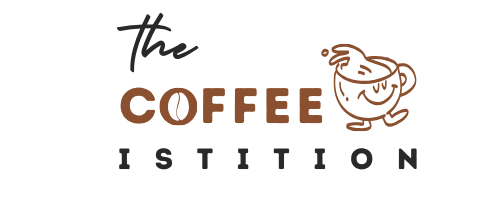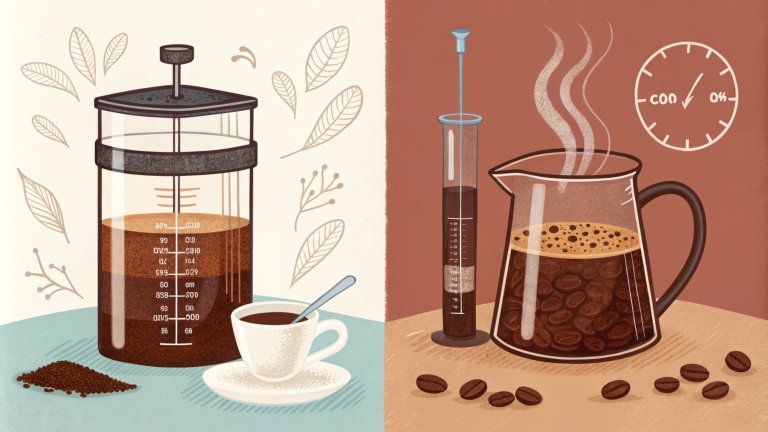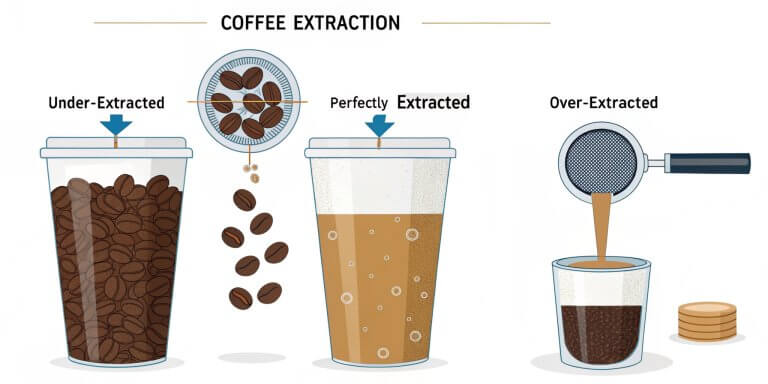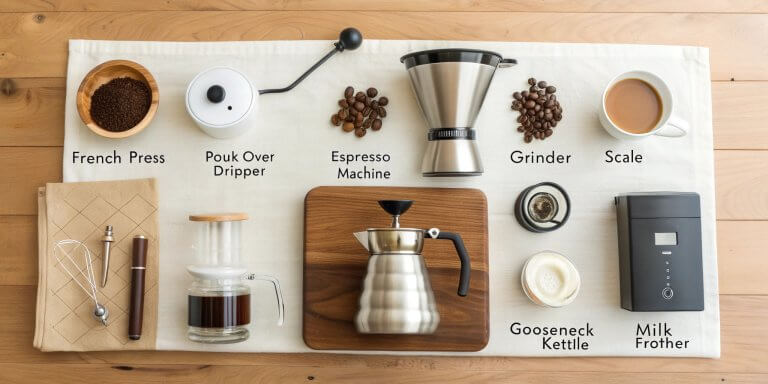Master Coffee Brewing: Temperature, Grind Size, & Extraction

Coffee brewing is both an art and a science. While some may enjoy throwing coffee grounds into a pot with hot water, true coffee lovers know brewing the perfect cup requires a deeper understanding of temperature, grind size, and extraction. Each factor significantly impacts the final flavor, and mastering them can turn an ordinary cup into an extraordinary experience. This guide explores these three essential aspects of coffee brewing and how to harness their power to elevate your daily coffee ritual.
The Basics of Coffee Brewing Science
At its core, coffee brewing is a process of extraction. When water passes through coffee grounds, it extracts various compounds, including acids, sugars, and oils, which contribute to the flavor of the coffee. Extraction determines how much of these compounds end up in your cup. Under-extraction or over-extraction can lead to an imbalanced flavor profile, so understanding this process is crucial to achieving a perfect brew.
Why Science Matters in Brewing?
Brewing coffee is about more than just adding hot water to coffee grounds. The quality of the water used can also significantly impact the brewing process. For instance, hard water with high mineral content can lead to over-extraction, resulting in a bitter taste, while soft water may not extract enough flavor, leading to a weak brew. Temperature affects how quickly compounds dissolve, grind size impacts the surface area of the coffee exposed to water, and extraction determines the strength and flavor of the coffee. Together, these scientific principles form the foundation of coffee brewing.
The Role of Temperature in Coffee Brewing
The recommended brewing temperature for coffee is between 195°F and 205°F (90°C – 96°C). This range allows optimal extraction, as it helps dissolve flavorful compounds without over-extracting bitter elements. If the temperature is too low, the coffee may taste sour and under-extracted, while a temperature too high can lead to bitterness and over-extraction.
What Happens if the Water is Too Hot or Too Cold?
Hot water speeds up extraction, while cold water slows it down. When the water is too hot, compounds are extracted too quickly, leading to an unbalanced flavor profile dominated by bitter compounds. On the other hand, if the water is too cold, essential acids and sugars may not fully dissolve, resulting in a weak and sour cup.
Tips for Controlling Water Temperature:
Using a kettle with temperature control can help you maintain the ideal brewing temperature. Alternatively, a thermometer can check the water temperature before brewing. Pour-over enthusiasts may also experiment with letting boiled water sit for 30 seconds before brewing, which typically lowers the temperature to the optimal range.
Understanding Grind Size and Its Impact on Flavor
Grind size refers to the particle size of the coffee grounds. The size of the grind affects the surface area of the coffee beans exposed to water, influencing how quickly flavors are extracted. Coffee can be ground into coarse, medium, or fine particles, each suitable for different brewing methods.
A finer grind increases the surface area, leading to faster extraction, while a coarser grind slows down the process. For example, espresso requires a fine grind to extract quickly under high pressure, whereas a French press benefits from a coarse grind due to the extended steeping time. Using the wrong grind size can lead to under or over-extraction, resulting in a bitter or sour flavor.
Choosing the Right Grind Size for Different Brewing Methods
- French Press: Coarse grind, similar to sea salt
- Pour-Over: Medium grind, resembling sand
- AeroPress: Fine to medium grind, depending on brew time
- Espresso: Fine grind, similar to table salt
- Cold Brew: Extra coarse grind, almost like rock salt
Common Mistakes and How to Avoid Them
Using a grind size that’s too fine or coarse for the brewing method is a common mistake. This can be avoided by adjusting the grind size based on the brewing method. Investing in a burr grinder, which produces more consistent particles, can also enhance your control over grind size.
Mastering the Art of Coffee Extraction
Extraction involves dissolving coffee compounds in water, where different elements dissolve at varying rates. The early extraction stages produce acids, the middle stage extracts sugars, and the late stage releases bitter compounds. One key part of the early extraction stage is the ‘bloom ‘, which is the initial release of gases from the coffee grounds when hot water is added. This process is a sign of fresh coffee and can contribute to the bright and tangy flavors in the early stage of extraction. Striking the right balance between these stages, including the bloom, is essential for a well-rounded flavor.
The Stages of Extraction
- Early Stage: Acids dissolve first, contributing bright and tangy flavors.
- Middle Stage: Sugars dissolve next, adding sweetness and body.
- Late Stage: Bitter compounds dissolve last, often leading to an unpleasant taste if over-extracted.
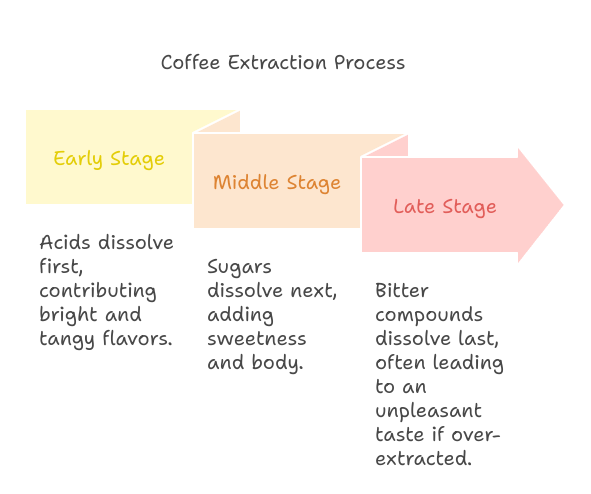
Finding the Balance: Avoiding Over and Under-Extraction
Signs of over-extraction include a bitter, astringent flavor, while under-extraction produces a sour and weak taste. You can avoid these issues by adjusting brew time, grind size, and temperature until you find the sweet spot that suits your palate.
Techniques to Control Extraction
Experiment with different brew times to achieve your desired flavor. For example, if your coffee tastes sour, it may be under-extracted, indicating that a longer brew time or finer grind could improve the flavor. In this case, you can try increasing the brew time by 30 seconds or using a slightly finer grind. Conversely, if your coffee tastes bitter, try shortening the brew time or using a coarser grind. For instance, you can reduce the brew time by 30 seconds or use a slightly coarser grind.
Temperature, Grind Size, and Extraction in Harmony
Temperature, grind size, and extraction are interconnected. Changing one factor affects the others. For instance, a finer grind requires a shorter brew time due to faster extraction, while a coarser grind may need more time and possibly a higher temperature to extract sufficient flavor.
Embrace the Adventure: creating a Perfect Brewing Profile for Your Taste By experimenting with these variables, you can find a brewing profile that suits your taste. Some prefer a slightly lower temperature for a smoother cup, while others enjoy a hotter brew for a more robust flavor. Grind size adjustments can further refine your brew based on personal preference.
The Role of Consistency in Achieving Desired Results Consistency is vital to mastering coffee brewing. Once you find a profile that works, use consistent measurements and techniques to replicate the results. A kitchen scale can help with precise measurements, and timing your brew will ensure consistent extraction.
Tools and Techniques to Enhance Your Coffee Brewing
Use a kettle with an adjustable thermostat for precise temperature control. Alternatively, you can monitor water temperature with a thermometer to maintain consistency.
Grinders: Burr vs. Blade
A burr grinder is preferable to a blade grinder for coffee brewing, as it provides a more consistent grind size. Blade grinders often produce uneven particles, leading to inconsistent extraction.
Brewing Methods That Maximize Control Over Temperature, Grind Size, and Extraction
Some brewing methods allow for more control over variables than others. Pour-over, AeroPress, and espresso are popular for enthusiasts who want to fine-tune their brew. These methods give you control over water temperature, grind size, and extraction time.
Troubleshooting Common Coffee Brewing Issues
If your coffee tastes bitter, it may be over-extracted, while sourness is a sign of under-extraction. Weak coffee often results from too little coffee or an overly coarse grind.
Step-by-Step Troubleshooting Guide
- Bitter Taste: Try a coarser grind, lower water temperature, or shorter brew time.
- Sour Taste: Use a finer grind, higher temperature, or longer brew time.
- Weak Flavor: Increase the coffee-to-water ratio or use a finer grind for better extraction.
How to Adjust Each Variable for Improvement?
Adjusting one variable at a time allows you to identify the cause of the issue. Start with grind size, then move on to temperature and extraction time until you achieve your desired flavor.
Conclusion
Mastering the science of coffee brewing involves understanding the complex interplay between temperature, grind size, and extraction. By exploring and experimenting with these variables, you can unlock the full potential of your coffee and discover new dimensions of flavor. Whether you’re a casual drinker or a dedicated coffee lover, a scientific approach to brewing can enhance your appreciation for the art of coffee.
